#Elastic Compute Cloud (EC2)
Text
Amazon Elastic Block Store, commonly known as EBS, is a significant component of Amazon Web Services (AWS) storage services, offering a versatile and reliable solution for managing data storage in the cloud. EBS allows users to create and attach block storage volumes to Amazon Elastic Compute Cloud (EC2) instances, making it an integral part of building scalable and high-performance applications on the AWS platform.
#amazon elastic block store#ebs#amazon web services#aws#ec2#amazon elastic compute cloud#cybersecurity#security#infosectrain#learntorise
0 notes
Text

code
#codeonedigest#cloud#aws#docker container#java#nodejs#javascript#docker image#dockerfile#docker file#ec2#ecs#elastic container service#elastic cloud computing#amazon ec2#amazon ecs#microservice#solid principle#python#kubernetes#salesforce#shopify#microservice design pattern#solid principles#java design pattern
0 notes
Text
Was sind die Vor- und Nachteile des Amazon EC2?:
"Vorteile und Nachteile des Amazon EC2: Ein DevOps Engineer Guide”
#AmazonEC2 bietet #Skalierbarkeit, #Flexibilität, #Kosteneffizienz und #Sicherheit. Mit der Cloud-Plattform steigern Sie Ihre #Verfügbarkeit und können Servicelevel-Agreemente nutzen. Vorteile wie #Automatisierung und die Elastic Compute Cloud machen das Ganze zu einer kosteneffizienten Lösung. #CloudComputing
Der Amazon Elastic Compute Cloud (EC2) ist ein Cloud-Computing-Dienst, der es Unternehmen ermöglicht, Ressourcen bereitzustellen und zu verwalten, um sich ihren Anforderungen anzupassen und in die Cloud zu skalieren. Mit Amazon EC2 können Unternehmen schnell und einfach Web- und Anwendungsressourcen hinzufügen, die Rechenleistung oder Speicherkapazität benötigen.
Der Amazon EC2 bietet viele…
View On WordPress
#Automatisierung#Cloud-Plattform#Elastic Compute Cloud.#Flexibilität.#Keywörter: Amazon EC2#Kosteneffizienz#Servicelevel-Agreement#Sicherheit#Skalierbarkeit#Verfügbarkeit.
0 notes
Photo
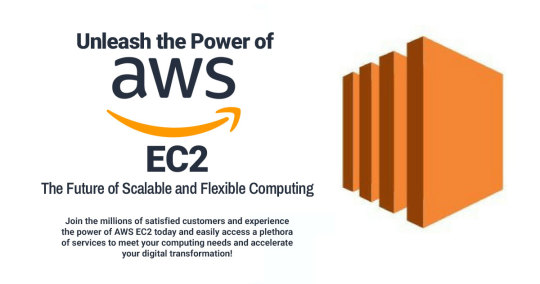
Amazon EC2 is a web service offered by AWS that provides resizable computing capacity in the cloud that can be used for a wide range of computing workloads.
#amazons aws#aws ec2#amazon ec2#elastic compute cloud#amazon elastic compute cloud#ec2 in cloud computing#aws training#aws cloud computing course#aws course#aws training and certification#aws certification training#aws certification course
0 notes
Text
Advantages of using the AWS Lab
Amazon Web Services (AWS) offers a variety of tools and services to help users develop and deploy their applications. One such tool is the AWS Lab, which is a cloud-based development environment that allows users to easily create, configure, and manage their development and testing environments.
The AWS Lab is built on top of the AWS Elastic Compute Cloud (EC2) and is integrated with other AWS services such as Amazon S3, Amazon RDS, and Amazon Elastic Block Store (EBS). This allows users to easily create and configure virtual machines with the necessary resources and configurations for their development and testing needs.
One of the key advantages of using the AWS Lab is that it allows users to quickly spin up and tear down development and testing environments as needed. This can greatly reduce the time and costs associated with setting up and maintaining physical development and testing environments. Additionally, the AWS Lab allows users to easily scale their environments as needed to accommodate changes in workloads and traffic.
Another advantage of the AWS Lab is that it provides a wide range of pre-configured environments, including popular development stacks such as LAMP, Ruby on Rails, and Node.js. This can greatly reduce the time and effort required to set up and configure a development environment.
In addition, the AWS Lab also provides a number of tools and features to help users manage and monitor their development and testing environments. For example, users can use the AWS Management Console to view detailed metrics and logs for their environments, as well as to set up alarms and notifications for specific events.
Overall, the AWS Lab is a powerful and flexible development environment that can greatly simplify the process of developing and testing applications on the AWS platform. Whether you're a small startup or a large enterprise, the AWS Lab can help you quickly and easily create, configure, and manage your development and testing environments, allowing you to focus on building great applications.
#AWS#Lab#cloud-based development#virtual machines#Elastic Compute Cloud (EC2)#Amazon S3#Amazon RDS#Amazon Elastic Block Store (EBS)#development stacks#LAMP#Ruby on Rails#Node.js#management console#metrics#logs#alarms#notifications
0 notes
Text
CLOUD COMPUTING: A CONCEPT OF NEW ERA FOR DATA SCIENCE
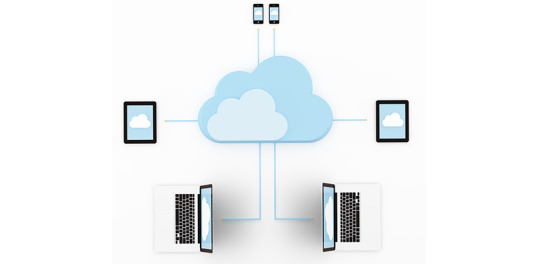
Cloud Computing is the most interesting and evolving topic in computing in the recent decade. The concept of storing data or accessing software from another computer that you are not aware of seems to be confusing to many users. Most the people/organizations that use cloud computing on their daily basis claim that they do not understand the subject of cloud computing. But the concept of cloud computing is not as confusing as it sounds. Cloud Computing is a type of service where the computer resources are sent over a network. In simple words, the concept of cloud computing can be compared to the electricity supply that we daily use. We do not have to bother how the electricity is made and transported to our houses or we do not have to worry from where the electricity is coming from, all we do is just use it. The ideology behind the cloud computing is also the same: People/organizations can simply use it. This concept is a huge and major development of the decade in computing.
Cloud computing is a service that is provided to the user who can sit in one location and remotely access the data or software or program applications from another location. Usually, this process is done with the use of a web browser over a network i.e., in most cases over the internet. Nowadays browsers and the internet are easily usable on almost all the devices that people are using these days. If the user wants to access a file in his device and does not have the necessary software to access that file, then the user would take the help of cloud computing to access that file with the help of the internet.
Cloud computing provide over hundreds and thousands of services and one of the most used services of cloud computing is the cloud storage. All these services are accessible to the public throughout the globe and they do not require to have the software on their devices. The general public can access and utilize these services from the cloud with the help of the internet. These services will be free to an extent and then later the users will be billed for further usage. Few of the well-known cloud services that are drop box, Sugar Sync, Amazon Cloud Drive, Google Docs etc.
Finally, that the use of cloud services is not guaranteed let it be because of the technical problems or because the services go out of business. The example they have used is about the Mega upload, a service that was banned and closed by the government of U.S and the FBI for their illegal file sharing allegations. And due to this, they had to delete all the files in their storage and due to which the customers cannot get their files back from the storage.
Service Models
Cloud Software as a Service
Use the provider's applications running on a cloud infrastructure
Accessible from various client devices through thin client interface such as a web browser
Consumer does not manage or control the underlying cloud infrastructure including network, servers, operating systems, storage
Google Apps, Microsoft Office 365, Petrosoft, Onlive, GT Nexus, Marketo, Casengo, TradeCard, Rally Software, Salesforce, ExactTarget and CallidusCloud
Cloud Platform as a Service
Cloud providers deliver a computing platform, typically including operating system, programming language execution environment, database, and web server
Application developers can develop and run their software solutions on a cloud platform without the cost and complexity of buying and managing the underlying hardware and software layers
AWS Elastic Beanstalk, Cloud Foundry, Heroku, Force.com, Engine Yard, Mendix, OpenShift, Google App Engine, AppScale, Windows Azure Cloud Services, OrangeScape and Jelastic.
Cloud Infrastructure as a Service
Cloud provider offers processing, storage, networks, and other fundamental computing resources
Consumer is able to deploy and run arbitrary software, which can include operating systems and applications
Amazon EC2, Google Compute Engine, HP Cloud, Joyent, Linode, NaviSite, Rackspace, Windows Azure, ReadySpace Cloud Services, and Internap Agile
Deployment Models
Private Cloud: Cloud infrastructure is operated solely for an organization
Community Cloud : Shared by several organizations and supports a specific community that has shared concerns
Public Cloud: Cloud infrastructure is made available to the general public
Hybrid Cloud: Cloud infrastructure is a composition of two or more clouds
Advantages of Cloud Computing
• Improved performance
• Better performance for large programs
• Unlimited storage capacity and computing power
• Reduced software costs
• Universal document access
• Just computer with internet connection is required
• Instant software updates
• No need to pay for or download an upgrade
Disadvantages of Cloud Computing
• Requires a constant Internet connection
• Does not work well with low-speed connections
• Even with a fast connection, web-based applications can sometimes be slower than accessing a similar software program on your desktop PC
• Everything about the program, from the interface to the current document, has to be sent back and forth from your computer to the computers in the cloud
About Rang Technologies:
Headquartered in New Jersey, Rang Technologies has dedicated over a decade delivering innovative solutions and best talent to help businesses get the most out of the latest technologies in their digital transformation journey. Read More...
#CloudComputing#CloudTech#HybridCloud#ArtificialIntelligence#MachineLearning#Rangtechnologies#Ranghealthcare#Ranglifesciences
8 notes
·
View notes
Text
Exploring the Power of Amazon Web Services: Top AWS Services You Need to Know
In the ever-evolving realm of cloud computing, Amazon Web Services (AWS) has established itself as an undeniable force to be reckoned with. AWS's vast and diverse array of services has positioned it as a dominant player, catering to the evolving needs of businesses, startups, and individuals worldwide. Its popularity transcends boundaries, making it the preferred choice for a myriad of use cases, from startups launching their first web applications to established enterprises managing complex networks of services. This blog embarks on an exploratory journey into the boundless world of AWS, delving deep into some of its most sought-after and pivotal services.

As the digital landscape continues to expand, understanding these AWS services and their significance is pivotal, whether you're a seasoned cloud expert or someone taking the first steps in your cloud computing journey. Join us as we delve into the intricate web of AWS's top services and discover how they can shape the future of your cloud computing endeavors. From cloud novices to seasoned professionals, the AWS ecosystem holds the keys to innovation and transformation.
Amazon EC2 (Elastic Compute Cloud): The Foundation of Scalability At the core of AWS's capabilities is Amazon EC2, the Elastic Compute Cloud. EC2 provides resizable compute capacity in the cloud, allowing you to run virtual servers, commonly referred to as instances. These instances serve as the foundation for a multitude of AWS solutions, offering the scalability and flexibility required to meet diverse application and workload demands. Whether you're a startup launching your first web application or an enterprise managing a complex network of services, EC2 ensures that you have the computational resources you need, precisely when you need them.
Amazon S3 (Simple Storage Service): Secure, Scalable, and Cost-Effective Data Storage When it comes to storing and retrieving data, Amazon S3, the Simple Storage Service, stands as an indispensable tool in the AWS arsenal. S3 offers a scalable and highly durable object storage service that is designed for data security and cost-effectiveness. This service is the choice of businesses and individuals for storing a wide range of data, including media files, backups, and data archives. Its flexibility and reliability make it a prime choice for safeguarding your digital assets and ensuring they are readily accessible.
Amazon RDS (Relational Database Service): Streamlined Database Management Database management can be a complex task, but AWS simplifies it with Amazon RDS, the Relational Database Service. RDS automates many common database management tasks, including patching, backups, and scaling. It supports multiple database engines, including popular options like MySQL, PostgreSQL, and SQL Server. This service allows you to focus on your application while AWS handles the underlying database infrastructure. Whether you're building a content management system, an e-commerce platform, or a mobile app, RDS streamlines your database operations.
AWS Lambda: The Era of Serverless Computing Serverless computing has transformed the way applications are built and deployed, and AWS Lambda is at the forefront of this revolution. Lambda is a serverless compute service that enables you to run code without the need for server provisioning or management. It's the perfect solution for building serverless applications, microservices, and automating tasks. The unique pricing model ensures that you pay only for the compute time your code actually uses. This service empowers developers to focus on coding, knowing that AWS will handle the operational complexities behind the scenes.
Amazon DynamoDB: Low Latency, High Scalability NoSQL Database Amazon DynamoDB is a managed NoSQL database service that stands out for its low latency and exceptional scalability. It's a popular choice for applications with variable workloads, such as gaming platforms, IoT solutions, and real-time data processing systems. DynamoDB automatically scales to meet the demands of your applications, ensuring consistent, single-digit millisecond latency at any scale. Whether you're managing user profiles, session data, or real-time analytics, DynamoDB is designed to meet your performance needs.
Amazon VPC (Virtual Private Cloud): Tailored Networking for Security and Control Security and control over your cloud resources are paramount, and Amazon VPC (Virtual Private Cloud) empowers you to create isolated networks within the AWS cloud. This isolation enhances security and control, allowing you to define your network topology, configure routing, and manage access. VPC is the go-to solution for businesses and individuals who require a network environment that mirrors the security and control of traditional on-premises data centers.
Amazon SNS (Simple Notification Service): Seamless Communication Across Channels Effective communication is a cornerstone of modern applications, and Amazon SNS (Simple Notification Service) is designed to facilitate seamless communication across various channels. This fully managed messaging service enables you to send notifications to a distributed set of recipients, whether through email, SMS, or mobile devices. SNS is an essential component of applications that require real-time updates and notifications to keep users informed and engaged.
Amazon SQS (Simple Queue Service): Decoupling for Scalable Applications Decoupling components of a cloud application is crucial for scalability, and Amazon SQS (Simple Queue Service) is a fully managed message queuing service designed for this purpose. It ensures reliable and scalable communication between different parts of your application, helping you create systems that can handle varying workloads efficiently. SQS is a valuable tool for building robust, distributed applications that can adapt to changes in demand.
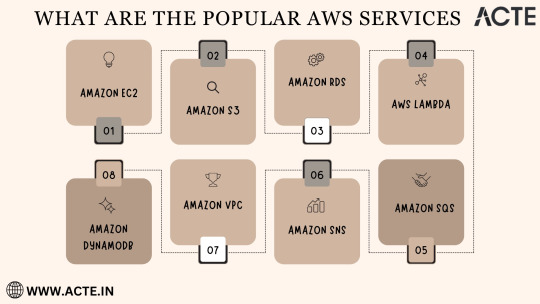
In the rapidly evolving landscape of cloud computing, Amazon Web Services (AWS) stands as a colossus, offering a diverse array of services that address the ever-evolving needs of businesses, startups, and individuals alike. AWS's popularity transcends industry boundaries, making it the go-to choice for a wide range of use cases, from startups launching their inaugural web applications to established enterprises managing intricate networks of services.
To unlock the full potential of these AWS services, gaining comprehensive knowledge and hands-on experience is key. ACTE Technologies, a renowned training provider, offers specialized AWS training programs designed to provide practical skills and in-depth understanding. These programs equip you with the tools needed to navigate and excel in the dynamic world of cloud computing.
With AWS services at your disposal, the possibilities are endless, and innovation knows no bounds. Join the ever-growing community of cloud professionals and enthusiasts, and empower yourself to shape the future of the digital landscape. ACTE Technologies is your trusted guide on this journey, providing the knowledge and support needed to thrive in the world of AWS and cloud computing.
8 notes
·
View notes
Text
EC2
Amazon Elastic Compute Cloud (Amazon EC2) is a web-based service that allows businesses to run application programs in the Amazon Web Services (AWS) public cloud. It offers Infrastructure as a service (IaaS). It provides complete control of computing resources, which one can scale as per the requirement.
AMAZON EC2 SPOT INSTANCE
EC2 reduces the time required to boot and obtain new server instances i.e. Amazon EC2 instances. It allows scaling capacity as per the computing requirements. Amazon EC2 provides system administrators and developers, isolation from failure scenarios by providing them tools to build failure-resilient applications
WHAT IS AN INSTANCE?
A virtual server used for running applications on Amazon’s EC2 is an instance. An instance can be understood as a small part of a large computer, having its own hard drive, network connection, OS, etc. You can have multiple small computers on a single physical machine, and all these small machines are called Instances.
HOW EC2 WORKS?
EC2 uses the AWS Management Console, the AWS Command Line Interface (CLI), or AWS Software Developer Kits (SDKs) for managing the scaling according to changing needs and makes it simple to deploy virtual servers and maintain storage.

BENEFITS OF AMAZON EC2
Reliability
Security
Flexibility
Cost Saving
Complete computing solution
11 notes
·
View notes
Text
Brazil VPS Hosting: Quick & Inexpensive Virtual Private Servers
When it comes to finding quick and inexpensive Virtual Private Servers (VPS) hosting in Brazil, there are several providers you can consider. Here are a few options:
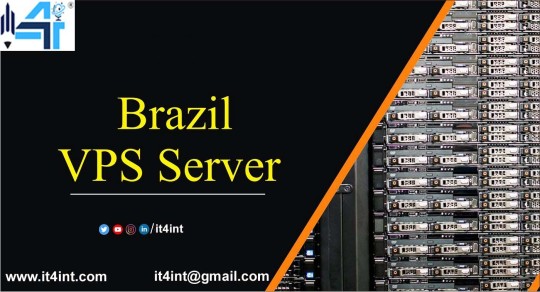
Hostinger: Hostinger offers VPS hosting with data centers in São Paulo, Brazil. They provide quick setup and competitive pricing for their VPS plans.
DigitalOcean: DigitalOcean has a data center in São Paulo, offering VPS hosting with SSD storage and a user-friendly interface for quick deployment.
Vultr: Vultr also has a presence in São Paulo and provides affordable VPS hosting with SSD storage, high-performance CPUs, and a range of data center locations globally.
Linode: Linode offers Brazil VPS hosting with a data center in São Paulo. They provide quick setup, SSD storage, and a variety of plans to choose from.
Amazon Web Services (AWS): AWS has a São Paulo region offering Elastic Compute Cloud (EC2) instances, which can be configured as VPS. While AWS may not always be the cheapest option, it provides scalability and reliability.
Before choosing a provider, consider factors such as server specifications, uptime guarantees, customer support quality, and scalability options. Additionally, make sure to check for any ongoing promotions or discounts that could help you save money on your VPS hosting.
#brazil windows vps#Brazil vps server pric#Best brazil vps server#buy vps server#Brazil vps price#VPS
2 notes
·
View notes
Text
Navigating the Cloud Landscape: Unleashing Amazon Web Services (AWS) Potential
In the ever-evolving tech landscape, businesses are in a constant quest for innovation, scalability, and operational optimization. Enter Amazon Web Services (AWS), a robust cloud computing juggernaut offering a versatile suite of services tailored to diverse business requirements. This blog explores the myriad applications of AWS across various sectors, providing a transformative journey through the cloud.
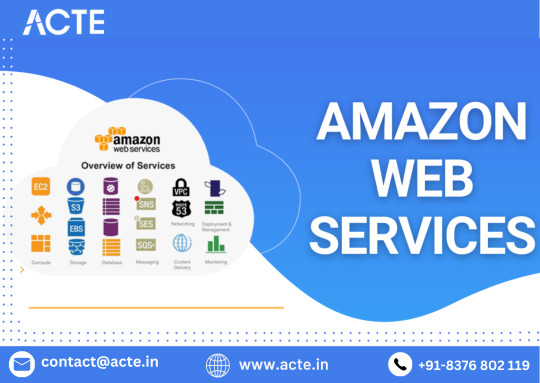
Harnessing Computational Agility with Amazon EC2
Central to the AWS ecosystem is Amazon EC2 (Elastic Compute Cloud), a pivotal player reshaping the cloud computing paradigm. Offering scalable virtual servers, EC2 empowers users to seamlessly run applications and manage computing resources. This adaptability enables businesses to dynamically adjust computational capacity, ensuring optimal performance and cost-effectiveness.
Redefining Storage Solutions
AWS addresses the critical need for scalable and secure storage through services such as Amazon S3 (Simple Storage Service) and Amazon EBS (Elastic Block Store). S3 acts as a dependable object storage solution for data backup, archiving, and content distribution. Meanwhile, EBS provides persistent block-level storage designed for EC2 instances, guaranteeing data integrity and accessibility.
Streamlined Database Management: Amazon RDS and DynamoDB
Database management undergoes a transformation with Amazon RDS, simplifying the setup, operation, and scaling of relational databases. Be it MySQL, PostgreSQL, or SQL Server, RDS provides a frictionless environment for managing diverse database workloads. For enthusiasts of NoSQL, Amazon DynamoDB steps in as a swift and flexible solution for document and key-value data storage.
Networking Mastery: Amazon VPC and Route 53
AWS empowers users to construct a virtual sanctuary for their resources through Amazon VPC (Virtual Private Cloud). This virtual network facilitates the launch of AWS resources within a user-defined space, enhancing security and control. Simultaneously, Amazon Route 53, a scalable DNS web service, ensures seamless routing of end-user requests to globally distributed endpoints.

Global Content Delivery Excellence with Amazon CloudFront
Amazon CloudFront emerges as a dynamic content delivery network (CDN) service, securely delivering data, videos, applications, and APIs on a global scale. This ensures low latency and high transfer speeds, elevating user experiences across diverse geographical locations.
AI and ML Prowess Unleashed
AWS propels businesses into the future with advanced machine learning and artificial intelligence services. Amazon SageMaker, a fully managed service, enables developers to rapidly build, train, and deploy machine learning models. Additionally, Amazon Rekognition provides sophisticated image and video analysis, supporting applications in facial recognition, object detection, and content moderation.
Big Data Mastery: Amazon Redshift and Athena
For organizations grappling with massive datasets, AWS offers Amazon Redshift, a fully managed data warehouse service. It facilitates the execution of complex queries on large datasets, empowering informed decision-making. Simultaneously, Amazon Athena allows users to analyze data in Amazon S3 using standard SQL queries, unlocking invaluable insights.
In conclusion, Amazon Web Services (AWS) stands as an all-encompassing cloud computing platform, empowering businesses to innovate, scale, and optimize operations. From adaptable compute power and secure storage solutions to cutting-edge AI and ML capabilities, AWS serves as a robust foundation for organizations navigating the digital frontier. Embrace the limitless potential of cloud computing with AWS – where innovation knows no bounds.
3 notes
·
View notes
Text
Title: Amazon EC2: Unleash Your Superpowers in the Cloud!
Introduction:
Welcome to the extraordinary world of Amazon Elastic Compute Cloud (EC2), where you can harness the power of the cloud to achieve remarkable feats. In this short and simple blog post, we'll explore the key features and benefits of Amazon EC2, empowering you to become a cloud computing superhero!

Elasticity and Scalability: With EC2, you have the ability to scale your compute resources up or down effortlessly. No task is too big or small as you adapt to changing workloads with ease.
Versatile Instance Types: EC2 offers a wide range of instance types tailored to your specific needs. Choose the perfect fit, whether you require general-purpose instances or high-performance computing clusters.
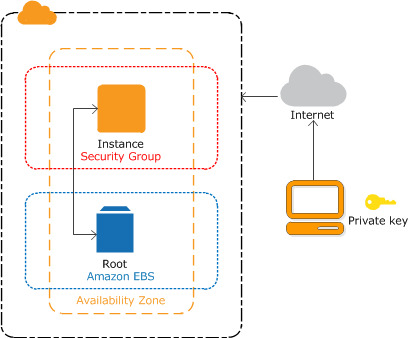
Security and Control: EC2 ensures the utmost security for your applications and data. You have complete control over your instances, including firewall settings and storage encryption, bolstering your defenses against threats.
Storage Options: EC2 provides flexible storage options, including persistent block-level storage (EBS) and scalable file storage (EFS). Leverage these options to securely store and access your data.
Seamless Integration: EC2 seamlessly integrates with other AWS services, allowing you to build comprehensive cloud architectures. Connect with databases, perform scalable data processing, and create a powerful ecosystem.

Conclusion:
With Amazon EC2, you possess the superpowers needed to conquer the cloud. Embrace the elasticity, select the right instance type, secure your applications, leverage storage options, and integrate seamlessly with other services. It's time to unleash your inner superhero and embark on an exciting cloud computing adventure with Amazon EC2!
15 notes
·
View notes
Text
EBS(Elastic Book Store)
Amazon Elastic Block Store (EBS) is a cloud storage service that provides persistent block storage volumes for Amazon Elastic Compute Cloud (EC2) instances. EBS volumes are highly available and durable, and they can be attached to any EC2 instance in the same Availability Zone.EBS volumes can be used to store a variety of data, including operating systems, applications, databases, and user data. EBS volumes are also a good choice for backing up data or for storing snapshots of EC2 instances.EBS is a highly scalable storage service that can be used to meet the needs of a wide range of workloads. EBS is a reliable and cost-effective way to store data in the cloud.
Benefits of using EBS for cloud computing :
1.Performance: EBS volumes offer high performance and consistent IOPS, even for demanding workloads.
2.Durability: EBS volumes are highly durable and are protected from data loss due to hardware failures.
3.Availability: EBS volumes are highly available and can be accessed even if an EC2 instance fails.
4.Cost-effectiveness: EBS volumes are a cost-effective way to store data in the cloud.
5.Scalability: EBS volumes can be scaled up or down to meet changing needs.
EBS is a powerful and versatile cloud storage service that can be used to meet the needs of a wide range of workloads. EBS is a reliable, scalable, and cost-effective way to store data in the cloud.
10 notes
·
View notes
Text
aws online training in ameerpet

Amazon Web Services (AWS) is a widely used cloud computing platform that provides a variety of services and tools for building, deploying, and managing applications in the cloud. As the demand for skilled AWS professionals continues to grow, APEC IT Training offers comprehensive AWS training programs that are designed to teach participants the skills necessary to become proficient AWS developers and administrators.The AWS training program offered by APEC IT Training covers a wide range of topics, including AWS core services, security and compliance, migration, and automation. Participants are also introduced to more advanced topics such as DevOps, machine learning, and big data.
The course usually starts with the basics of AWS, including AWS Identity and Access Management (IAM), Elastic Compute Cloud (EC2), and Simple Storage Service (S3). Participants then move on to more advanced topics such as building scalable and fault-tolerant applications using AWS services such as Elastic Load Balancing, Auto Scaling, and Route 53.The training program also covers best practices for securing and complying with AWS services, migrating applications to AWS, and automating infrastructure using AWS CloudFormation and AWS CodePipeline.
visit: http://www.apectraining.com/aws/
2 notes
·
View notes
Text
Welches sind die am besten geeigneten Tools & Frameworks zur Entwicklung von AWS-Cloud-Computing-Anwendungen?:
"Entwicklung von AWS-Cloud-Anwendungen: Die besten Tools & Frameworks von MHM Digitale Lösungen UG"
#AWS #CloudComputing #AWSLambda #AWSEC2 #ServerlessComputing #AmazonEC2ContainerService #AWSElasticBeanstalk #AmazonS3 #AmazonRedshift #AmazonDynamoDB
In der heutigen digitalen Welt ist Cloud-Computing ein Schlüsselthema, vor allem bei aufstrebenden Unternehmen. AWS (Amazon Web Services) ist der weltweit führende Cloud-Computing-Anbieter und bietet eine breite Palette an Tools und Frameworks, die Entwicklern dabei helfen, schneller und effizienter zu arbeiten. In diesem Artikel werden die besten Tools und Frameworks erörtert, die für die…
View On WordPress
#Amazon DynamoDB.#Amazon EC2 Container Service#Amazon Redshift#Amazon S3#Amazon Web Services#AWS EC2#AWS Elastic Beanstalk#AWS Lambda#Cloud Computing#Serverless Computing
0 notes
Text
AWS U7i Instances Transforming In-Memory Computing

Amazon EC2 U7i
Amazon Elastic Compute Cloud (Amazon EC2) U7i instances with up to 32 TiB of DDR5 memory and 896 vCPUs are now available, having been unveiled in preview. These high memory instances, which are driven by specially engineered fourth generation Intel Xeon Scalable Processors (Sapphire Rapids), are intended to serve big, in-memory databases, such as SAP HANA, Oracle, and SQL Server.
What makes Amazon EC2 so special?
With over 750 instances and a selection of the newest processors, storage, networking, operating systems, and pricing models to help you best match the requirements of your workload, Amazon Elastic computational Cloud (Amazon EC2) provides the broadest and deepest computational platform available. Amazon is the first cloud provider with 400 Gbps Ethernet networking, the first major cloud provider to support AMD, Intel, and Arm processors, and the only cloud offering on-demand EC2 Mac instances. Amazon provide the lowest cost per inference instance in the cloud along with the highest pricing performance for machine learning training. AWS supports more workloads related to Windows, SAP, the HPC, and machine learning than any other cloud.
The new instances offer the most memory and computation capacity of any SAP-certified virtual instance from a top cloud provider, and they also deliver the greatest compute pricing performance for big in-memory workloads.
AWS Nitro System
All of the instance’s memory is usable because of Amazon Nitro System. Here is the 32 TiB instance, for illustration:Image credit to Amazon
Amazon Nitro Framework
The foundation of Amazon’s upcoming generation of EC2 instances, the AWS Nitro System, allows AWS to innovate more quickly, further lower costs for Amazon’s clients, and provide additional instance kinds and enhanced security, among other benefits.
Amazon has a whole new virtualization infrastructure thanks to AWS. Conventionally, hypervisors offer a wide range of administration functions, virtualize the CPU, storage, and networking, and safeguard the actual hardware and BIOS. Amazon can separate those operations, transfer them to specialised hardware and software, and lower expenses by providing your instances with nearly all of a server’s resources thanks to the Nitro System.
Advantages
Quicker invention
Amazon can rapidly and efficiently develop EC2 instance types with growing computing, storage, memory, and networking capabilities with the Nitro System. The System is a versatile set of building elements. Additionally, this invention paves the way for bare metal scenarios in which clients are free to supply their own or no hypervisor.
Increased protection
Enhanced security is offered by the Nitro System, which continuously checks, safeguards, and validates the firmware and hardware of the instance. The attack surface is reduced by offloading virtualization resources to specialised hardware and software. Last but not least, the security model of Nitro System is shut down and forbids administrative access, removing the chance of tampering and human error.
Enhanced functionality and cost
Your instances will run better overall since the Nitro System provides nearly all of the host hardware’s computation and memory resources to them. Moreover, high-speed networking, high-speed EBS, and I/O acceleration are made possible by specific Nitro Cards. More savings that can be transferred to the customer result from not needing to reserve resources for management software.
Support for instances from earlier generations
The AWS Nitro System can prolong the duration of operation beyond the standard lifespan of underlying hardware by supporting EC2 instances from earlier generations. By offering clients the ability to execute their workloads on the instance families they were created on, the AWS Nitro System gives customers access to cutting-edge hardware and software components for EC2 instances.
The Amazon EC2 U7i instances provide up to 115% greater memory performance, 2.5 times the EBS bandwidth, and more than 135% more compute performance than the previous generation of EC2 High Memory instances. With this improved capacity, data loads and cache refreshes can happen faster than ever before you can move 30 TiB of data from EBS into memory in an hour or less. The instances offer an 85% reduction in P99.9 latency across instances and support ENA Express with 25 Gbps of bandwidth per flow.
ENA Express
Amazon have made every effort to provide you with the network performance and bandwidth that you can utilise to the fullest extent possible. Network bandwidth increased over time, from 250 Mbps on the first m1 instance to 200 Gbps on the most recent m6in instances. Amazon have added advanced networking features like Enhanced Networking, Elastic Network Adapters (ENAs), and Elastic Fabric Adapters (EFAs) (for tightly connected HPC applications) in addition to sheer bandwidth.
AWS ENA Express
Announcing ENA Express
Amazon is introducing ENA Express today. ENA Express increases the maximum single-flow capacity from 5 Gbps to 25 Gbps and decreases P99 latency of traffic flows by up to 50% and P99.9 latency by up to 85% (compared to TCP), building on the Scalable Reliable Datagram (SRD) protocol that currently drives Elastic Fabric Adapters. In summary, you get significantly less unpredictability and a lot more per-flow capacity.
To benefit from this performance immediately for TCP and UDP traffic between c6gn instances running in the same Availability Zone, you can enable ENA Express on both new and old ENAs.
Using ENA Express
Using ENA Express To set up and test ENA Express, Jeff Barr used two c6gn instances. He enabled ENA Express for both instances using the AWS Management Console after he launched the instances. He locate every ENI, pick it, and then from the Actions menu, select Manage ENA Express:Image credit to Amazon
Up to 128 General Purpose (GP2 and GP3) or Provisioned IOPS (IO1 and IO2 Block Express) EBS volumes can be attached to each Amazon EC2 U7i instance. io2 Block Express volumes are a perfect fit for Amazon EC2 U7i instances because each one can hold up to 64 TiB and give up to 256K IOPS at up to 32 Gbps.
The instances are certified by SAP to operate SAP BW/4HANA, Business Suite on HANA, Business Suite S/4HANA, and Business Warehouse on HANA (BW) in production settings. Refer to the SAP HANA to AWS Migration Guide and the Certified and Supported SAP HANA Hardware for additional information. Don’t forget to look at the SAP AWS Launch Wizard as well.
Important Information
You should be aware of the following two facts regarding these recent occurrences:
Regions
The US East (North Virginia), US West (Oregon), and Asia Pacific (Seoul, Sydney) AWS Regions are where Amazon EC2 U7i instances are accessible.
Operating Systems
Windows Server, Ubuntu, Red Hat Enterprise Linux, SUSE Linux Enterprise Server, and Amazon Linux are among the supported operating systems.
Greater Instances
To further serve Amazon’s customers,Amazon plan to provide even larger instances with more compute later this year.
Read more on govindhtech.com
#AmazonEC2#AmazonEC2U7i#Amazon#DDR5memory#SQLServer#machinelearning#enaexpress#AWS#software#hardware#news#technews#technology#technologynews#technologytrends#govindhtech
0 notes
Text
https://www.iteducationcentre.com/amazon-web-services-training-institute-in-pune.php
With ten years of experience in web development and web security services, IT Education Center's skilled trainers provide AWS training in Pune. AWS services include Cloud Computing, EC2, Auto Scaling, VPC, ELB, SNS, SES, SQS, Route 53, IAM, S3, Glacier Storage, CloudWatch, CloudFront, RDS, DYNAMODB, and Elastic Beanstalk are all covered in detail in the curriculum. Participants will become proficient in creating and executing AWS solutions through theoretical lectures, practical exercises, and capstone projects. This all-inclusive method gives students the skills they need to succeed as certified AWS professionals. Furthermore, the IT Education Center's active placement cell makes sure students are linked and well-prepared, opening doors for chances with prestigious companies.
0 notes